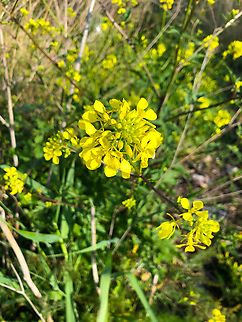
Appearance
"Rhamphospermum arvense" reaches on average 20–80 cm in height, but under optimal conditions can exceed one metre. The stems are erect, branched and striated, with coarse spreading hairs especially near the base. The leaves are petiolate with a length of 1–4 cm. The basal leaves are oblong, oval, lanceolate, lyrate, pinnatifid to dentate, 4–18 cm long, 2–5 cm wide. The cauline leaves are much reduced and are short petiolate to sessile but not auriculate-clasping. It blooms from May to September, or May to August, in the UK. The inflorescence is a raceme made up of yellow flowers having four petals with spreading sepals. The fruit is a silique 3–5 cm long with a beak 1–2 cm long that is flattened-quadrangular. The valves of the silique are glabrous or rarely bristly, three to five nerved. The seeds are dark red or brown, smooth 1-1.5 mm in diameter.Naming
The former generic name "Sinapis" derives from the Greek word "sinapi" meaning 'mustard' and was the old name used by Theophrastus for any mustard. The specific epithet "arvense" is a Latin adjective meaning 'from/of the field'.Distribution
A native of the Mediterranean basin, from temperate regions of North Africa, Europe and parts of Asia. It has also become naturalised throughout much of North America, South America, Australia, Japan and South Africa.Habitat
It grows in the plains and mountains, in pastures, fields, roadsides, waste places, and ruins, but mainly in cultivated places. It prefers calcareous soils in sunny places, at an altitude of 0–1,400 m above sea level.The flowers are pollinated by various bees like "Andrena agilissima" and flies. "Rhamphospermum arvense" is the host plant of the caterpillars of some Lepidoptera, such as the small white, "Pieris rapae". The seeds are toxic to most animals, except birds, and can cause gastrointestinal problems, especially if consumed in large quantities.It is a highly invasive species in states such as California.
Uses
The leaves of wild mustard are edible at the juvenile stage of the plant; they are usually boiled, such as in 18th century, in Dublin, where it was sold in the streets. During the Great Famine of Ireland, wild mustard was a common famine food, even though it often caused stomach upset. Once the seeds are ground, they produce a kind of mustard.A type of oil can be extracted from the seed which has been used for lubricating machinery.
References:
Some text fragments are auto parsed from Wikipedia.